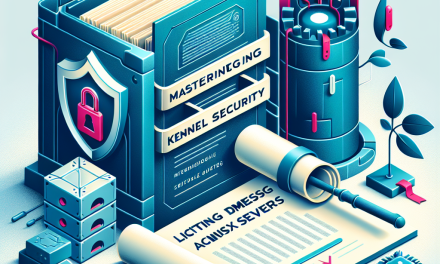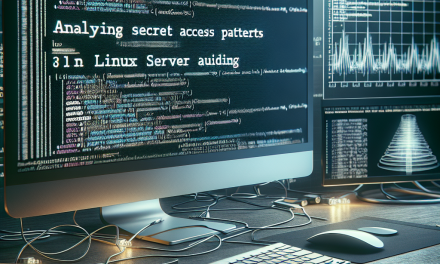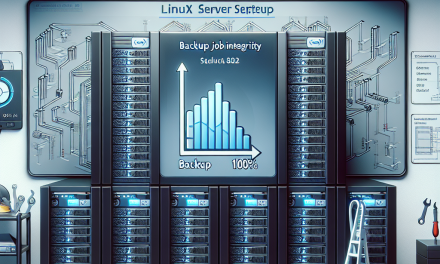In an increasingly digital landscape where cyber threats are constantly evolving, maintaining the integrity of your systems is crucial. One of the most effective ways to safeguard your data and ensure that unauthorized changes are not made to critical files is through file integrity monitoring. In this article, we will explore how to use Tripwire, a powerful open-source tool, for monitoring file integrity on Linux servers.
What is Tripwire?
Tripwire is a host-based intrusion detection system (HIDS) that monitors and alerts on changes to the files and directories within the system. Originally developed in 1990, Tripwire helps in detecting unauthorized changes to important files, which can be a tell-tale sign of a security breach. Tripwire creates a baseline snapshot of your file system, enabling you to track changes over time and respond swiftly to any unauthorized modifications.
Why Use Tripwire?
- Change Detection: Tripwire detects changes in files, directories, and permissions—providing vital information about potentially unauthorized modifications.
- Compliance: Many organizations must comply with regulations such as PCI DSS, HIPAA, and others. Tripwire’s monitoring capabilities can aid in demonstrating compliance.
- Ease of Use: Once properly configured, Tripwire can provide ongoing monitoring with minimal manual intervention.
- Open Source: Being open-source software, Tripwire is free to use and modify, making it a cost-effective solution for many organizations.
Installing Tripwire on Linux
Before you start using Tripwire, you’ll need to install it on your Linux server. Most Linux distributions have Tripwire packages available in their repositories. Here’s how to install Tripwire on a Debian-based system (such as Ubuntu):
sudo apt update
sudo apt install tripwireFor Red Hat-based systems, you can use:
sudo yum install tripwireDuring installation, you’ll be prompted to configure Tripwire. Follow the prompts to set up your site and site passphrase.
Initial Configuration
Once Tripwire is installed, the next step is to configure the system to monitor the necessary files and directories.
-
Edit Tripwire Configuration File: Tripwire’s configuration files are typically located in
/etc/tripwire/. You will find bothtw.configandtw.polfiles, wheretw.configis the main configuration file, andtw.poldefines the policies for what Tripwire will monitor.Edit the
tw.polfile to specify which files and directories to monitor. Here’s an example entry:(
rulename = "essential files",
severity = 100,
email = ( "[email protected]" ),
check = ( all )
) - Initialize the Database: After configuring your policies, you need to initialize the Tripwire database that contains the current state of monitored files. Use the following command:
sudo tripwire --init- Generate Baseline: This command creates a baseline report of all monitored files, which Tripwire will compare against in future checks.
Running Tripwire
After the initial setup, you can run Tripwire checks at any time to see if there have been unauthorized changes. To perform a check, use:
sudo tripwire --checkUpon completion, Tripwire generates a report, usually located in /var/lib/tripwire/report/. The report outlines any changes that have been detected since the last baseline was established.
Reviewing and Responding to Reports
After running a check, you can review the report to see the changes. Typical reports will highlight:
- Modified files
- New files
- Removed files
- Changes in file attributes
Taking Action
If Tripwire detects unauthorized changes, you will need to take appropriate actions:
- Validate Changes: Determine whether the changes were legitimate (like a system update) or an indicator of a breach.
- Restore Files: If files were changed or deleted maliciously, you can restore them from backup.
- Adjust Configurations: If legitimate changes were often flagged by Tripwire, adjust your configuration to account for them.
Automating Checks and Alerts
To ensure consistent monitoring, you can automate Tripwire checks using cronjobs. For instance, to run checks daily and send alerts, you can add a cron job by editing the crontab:
sudo crontab -eAdd the following line for daily checks at 2 AM:
0 2 * * * /usr/sbin/tripwire --check >> /var/log/tripwire.logThis entry sends the output of the check to a log file, where you can review it later.
Conclusion
File integrity monitoring is a crucial aspect of maintaining the security and integrity of Linux servers. By implementing Tripwire, organizations can detect unauthorized changes promptly, helping to safeguard their systems from potential threats. With its ease of configuration and powerful monitoring capabilities, Tripwire is a valuable tool in any security toolkit.
For more articles and resources on Linux security, stay tuned to WafaTech Blog. Happy securing!





